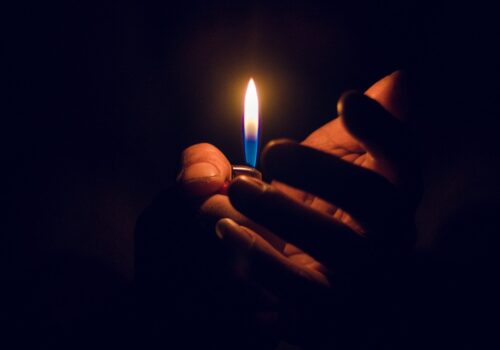Download PDF: Gade, Response to Orsi
* Editors’ Note: This essay is part of the Roundtable on Ethnography and Religion.
Robert Orsi makes a suggestion for powerful intersubjective understanding of the religious lifeworlds that bind “heaven and earth” and we humans together: he proposes that graduate programs in religious studies “require for all their students a season of self-reflexive fieldwork among religious practitioners.” We know that religious studies is more than a presentist study of social systems. I think this proposal is more rhetorical than programmatic, relating to concerns Orsi presents about engagement, writing, and the categories of the academic study of religion. I would like to take up each of these ideas in light of the idea of “fieldwork in religious studies,” its limits, and Orsi’s essay. I agree with what he has to say.
There is a brief point to make at the outset. Orsi appears to carry his position on fieldwork rather farther than does the standard “anthropological turn” in religious studies (or the ongoing discovery of “religion” in anthropology). The excitement about ethnographic methods for religious studies built all through the 1990s, and now it is here to stay. This has certainly been the case in my own field, Islamic studies, and even in my own research in the nineties on Qur’anic scripture and performance that theorized (others’) “experience.”1 For the study of Islam, and religion more generally, however, Orsi suggests much more than did Edward Said decades ago when he praised Clifford Geertz for pointing to the need to bring real people into the picture (a point that is still made in Islamic studies).2
Orsi stops short of claiming, however, that fieldwork is good just for its own sake or for the scholar’s sake. We agree: fieldwork in the academic study of religion should not be just for the end of complementing the “religious experience” of the investigator in some personally meaningful way. Although I have worked on emotion and affect since that first project on the recited Qur’an, for example, the fieldnotes, the write-up, and the theory were not carried out in terms of sharing directly in informants’ performative, educative, or sentimental experience. In fact, many of the important things fieldwork can do in religious studies relate to limits as much as to “wholeness” with respect to experience, expression, and understanding. I would now like to consider such limits, below, considering three key points in Orsi’s essay.
First, in the title, Orsi tells us that “your whole body” should do the study of religion. Orsi writes with depth and great sensitivity on bodies and Roman Catholic piety, here and elsewhere; however, in this piece, we do not read a theory of embodiment exactly. Orsi maybe means instead an “engagement,” perhaps what he calls elsewhere a “moral conversation,” which would break down complacency. It is often true that being face-to-face with actual people prompts attention and possibly irreducible “wholeness.” However, I am not so sure that it is always, or primarily, the experience of fieldwork that provides this in the academic study of religion—or even that this is what it should be expected to provide. Fieldwork does not automatically, nor does it always, produce results of authenticity and engagement in religious studies, nor is it really safe to say that requiring students to do it would make our students any more authentic or engaged than they would otherwise tend to be.
I was invited by the editors of Practical Matters to use my own fieldwork as an example. I spent most of a year in Cambodia engaging the lifeworlds of survivors of the regime of Democratic Kampuchea (the “Pol Pot” era), and also considering how religious revitalization overlapped with experiences of recovery. I edited a book of survivor accounts (The Cham Rebellion: Survivors’ Stories from the Villages by Ysa Osman) and heard many more stories in the field from informants, friends, and a few called “family.”3 In work not directly related to documentation of the Muslim experience of what is called the “Cambodian genocide,” it was still common, nevertheless, to be shown scarred landscapes and bodies, living and dead. In my fieldwork, this was often the painfully formal, awkwardly distanced introduction I was given to an important place or person. I came to understand that this was not necessarily a gesture of intimacy, but rather an appeal. I was challenged to write and theorize about these moments not primarily as an immediate felt response, but rather in terms of imaginaries of patronage and structures of development (the same framework into which I was also cast as an investigator).
Maybe it’s only in America that we (Americans) can expect students to “understand” subjects through themselves—and maybe, too, this is a positive exceptionalism for the field brought about by a North Americanist turn in religious studies theory overall in the past decade. Orsi’s beautiful book, Between Heaven and Earth, blends reflections on fieldwork with personal experience.4 Family ties, like the ones about which Orsi writes that bind us in and to “the field,” can make scholars more engaged and entwined, even if we ultimately “write about” something or someone else. But what matters in the end for the discipline is writing (including what goes without saying and what remains unsaid). In any case, it’s safe to say that there are many kinds of fieldwork that, while “self-reflexive” (Orsi’s term), do not promote much empathetic engagement in the course of writing in the way that I think Orsi imagines. Examples come to mind of fieldwork conducted according to many disciplines without working knowledge of a language spoken by subjects, including studies of Cambodia, some survey-based research, and empirical work on theories of mind.
Second, Orsi writes that to encourage fieldwork is an “existential and ethical” position, which relates to pedagogy and method in religious studies. There ought to be no limited, “illusory wholeness,” he writes, no smugness nor the “shells” of self-protective stances. He emphasizes “the engine of our theory paused.” But, just like a whole-body problem above, I am not yet convinced that it is the religious experience of fieldwork that overcomes challenges of an overly thin description, or at least not as much as a radical empiricist of an American phenomenological tradition, like William James, could make us willing to believe. And, as Orsi’s own work shows profoundly, sources of the self are hybrid and fragmentary and subject to the mechanisms of memory.
Orsi argues that a related pause in research and writing happens automatically, in his account of the investigator who returns to his or her campus to reread accounts of suffering. The moments of interruption Orsi rehearses in his piece interrupt not really in the field but in our studies (so is it more fieldwork that our students or we would need at such a juncture?). I think what Orsi shows being “paused” self-reflexively in the discipline of religious studies is not theory, but the hard work of writing. Like Jonathan Z. Smith, Orsi here challenges our limits of explanation in the academic study of religion.5 This is the “practice” I read about in his piece, which, as he states, is one that ideally “scholars of religion continue throughout the rest of their lives.”
Orsi suggests that a scholar’s block is not always exceptional, not necessarily a limit case nor a case-sensitive exception. Coming naturally as a response, it also may be generalized, after the brilliant work of Daniel Gold, as a critical matter of writing on religion.6 This notion overlaps with classic problems of ethnographic writing, but expands them as well: for example, Gold describes a scholar’s “fascination” with the religions of others, assimilated through his or her non-“religious sensibility.” Most important, Gold recognizes the “ambivalent feelings” scholars may have when they “like religion” and also “believe in science”— feelings that “draw them to the stuff of religious life but keep them twice removed from it.”7 In a “self-reflexive” moment that demands analysis, which is naturally impossible, more fieldwork and less theory could help— or maybe not. Times like these already lead naturally to take refuge in the documentary (I try to make films now); “transcription,” according to Orsi; or in the all-too-fine details of “translation.”8 Gold identifies such a dilemma of writing as a fundamental problem of “aesthetics” related to the categories used to analyze religion.
Third, Orsi writes that he seeks “what religion is,” not what is bounded or merely in “control.” This statement seems prompted not by essentialism, but rather by a “failure of empiricism,” as he writes: for one thing, our data are now just too big. If the “field” includes cosmological and internal space, the lifeworlds we study truly are unruly. However, should it follow that theory is an obstacle to explanation or understanding, especially if our ideas are what directed us into “the field” to start? Even fifty years ago, Clifford Geertz recognized moral and existential overload like this (“complexity”) as his new anthropology of religion challenged “interpretation” and “commitment,” “presence” and “encounter” to stretch to their very “limits” in his famous essay.9 Nobody wants to ignore salient data, overlook significant details, or ever miss the point. Also, good theory should never prevent us from seeing anything relevant that is really there.
Alongside “pausing theory,” then, an elegant paradox is not a surprise when Orsi states that the “theoretical languages” of the human sciences and especially “theological terms” need to be extended beyond present limits. This also presents a practical matter: an actual interruption so profound that it requires the recovery of “terms that theologians themselves have either abandoned or suborned into doctrinal and philosophical squabbles.” More fieldwork all by itself does not offer a very great solution here either—but it points to good problems in the academic study of religion. For example, Orsi calls for an expansion of the “human side” of religion to include unseen forces and futures, as well as the ethical connections that scholars share with our subjects.
I support what Orsi has to say. In the fieldwork project I now have carried out over three years in Indonesia on religion and environmentalism, the problem is a simple one that all our bodies share—the degradation of the earth which sustains all life itself. Religion and ecological challenge also present systems with more variables than academic theory is equipped to handle in religious studies, especially when real people and their lived ecosystems are present in analysis. This confrontation confuses self-reflexivity, as it is a full-scale collision with ethnographic “complexity,” as Geertz first meant the term in “Religion as a Cultural System.”
So far, many of the religious environmental activists in my research field (in this case, Muslim Indonesia), as in the United States and elsewhere, take upon themselves a task of perception: they ask how to get others to be present, embodied, and engaged enough to really care about ecological crisis. At first it seems like a straightforward academic assignment comes out of this: to analyze messages contextually (do people want to change attitudes? light bulbs? rethink legal norms? transform political economy?) However, as I come home to view and review preaching out of the religious imagination, the norms and aesthetics of seen and unseen worlds shift into new zones of existential immediacy and mathematical difficulty. For example, micro- and macro-cosmic ecological futures, the scientific and divine consequences of present action, are described in my materials in terms of esoteric ideas. Even theories of apocalypticism are inadequate to explain how real people confront the end of this world and the unknown state of a world to come in intellectual, affective, and embodied modes. Writing up field materials poses a theoretical and ethical conundrum, for whose solution no scale or dimension, human or non-human, can be ruled out, not by anyone’s account, and for everyone’s sake. And added to that, we are all living it, too, in real times.
“Religion,” for the sake of an analysis at this point, is not a sui generis category, but it is, nevertheless, one that compels deep analysis, empirically and “essentially,” in the spirit of Orsi’s appeal. In these data, “religion” is the stuff through which people understand and address the idea and reality of the ultimate transformation of human and non-human worlds, as well as their responsibility and struggle in the face of perceived crisis. In the case of Muslim religious responses to environmental change, Islam is a resource to which humans turn to approach environmental well-being, and warn of catastrophe, while simultaneously it promises tools to apprehend cosmological and ethical complexity itself. What makes writing on this naturally impossible, then, are not the fuzzy sets beyond (or “between”) “sacred and profane,” or the standard variations on themes of knowledges, local and global, but also a time-driven lack of determinism that should now leave us shaken and unsettled. In this field, to which our “whole bodies” as well as the biosphere are subject, we must now be present, take pause, and move beyond limitations to share work.
Notes
- Anna M. Gade,Perfection Makes Practice: Learning, Emotion and the Recited Qur’an in Indonesia (Honolulu: University of Hawai’i Press, 2004) and The Quran: An Introduction (Oxford, U.K.: Oneworld Publications, 2010).
- Edward Said,Orientalism (New York: Vintage Books, 1978), 326.
- Ysa Osman,The Cham Rebellion: Survivors’ Stories from the Villages, ed. Anna M. Gade (Phnom Penh: Documentation Center of Cambodia, 2006).
- Robert Orsi,Between Heaven and Earth: The Religious Worlds People Make and the Scholars Who Study Them (Princeton, NJ: Princeton University Press, 2006).
- See essays in Jonathan Z. Smith,Imagining Religion: From Babylon to Jonestown (Chicago: University of Chicago Press, 1988).
- Daniel Gold,Aesthetics and Analysis in Writing on Religion: Modern Fascinations (Berkeley: University of California Press, 2003), 5.
- Ibid., 5.
- http://vimeo.com/hijau
- Clifford Geertz, “Religion as a Cultural System.” InThe Interpretation of Cultures: Selected Essays (New York: Basic Books, 1973), 87-125.






